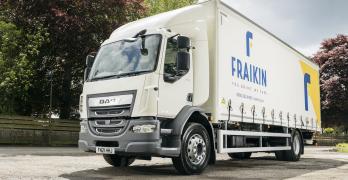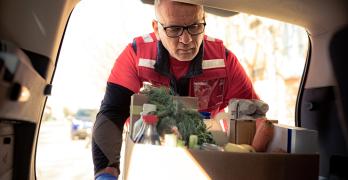Transport: The promise of hydrogen
- 29/09/23
- 5 min
A clean and harmless gas, hydrogen has many advantages in the perspective of a decarbonised supply chain. But it also has a few weaknesses that need to be overcome if this clean energy is to find its way onto the roads of the UK and beyond...

Hydrogen has raised many hopes in the transport sector and in particular the world of logistics. "Used on heavy goods vehicles or vans, this energy would theoretically make it possible to double or triple the current EV (Electric Vehicle) range and considerably reduce the recharging time," explains Olivier Dutrech, Fraikin's Director of Innovation. In short, an ideal candidate to replace fossil fuels in the long term.
In the world of transport, the dominant technology is the fuel cell (PAC in acronym). These are vehicles with conventional electric propulsion, whose engine is continuously powered by a fuel cell, which supplies electricity from hydrogen, via reverse electrolysis. This eliminates the need for heavy and cumbersome batteries, as the fuel cell acts as a small on-board power plant. There is also another technology that consists of using hydrogen directly as a conventional fuel in an internal combustion engine, but this is marginal for the moment. The technology is therefore far from being stabilised.
Hydrogen: The advantages of 100% clean gas...
On paper, the fuel cell has many advantages. The conversion of hydrogen into electric current produces only water and nothing else. No CO2, NOx or particulates from the exhaust pipe, so its balance from engine to wheel is excellent.
Another advantage is that it takes just as long to fill up as a combustion engine vehicle: a few minutes, compared with several hours for a battery-powered electric vehicle on a normal charge, or several tens of minutes on a fast charge.
Be aware however, that these types of vehicles emit fine particles during braking.
The production challenge
Hydrogen would be an ideal fuel if it did not have a few drawbacks. The main drawback is the way it is produced. Hydrogen is very abundant in the universe, but it does not exist naturally on earth. There are no hydrogen deposits. It must therefore be produced, either by electrolysis or by chemical processes. Solutions that consume a lot of energy and therefore seriously undermine its carbon footprint appeal.
This disadvantage, however, does not mean that hydrogen is off the table, far from it. In fact, everything depends on the energy used for its production. If it is produced using fossil fuels such as oil or coal, the balance sheet is not great. If, on the other hand, it is based on low-carbon energies such as nuclear or, better still, green energies such as wind power, this gas is still very appealing.
Hydrogen: Tanks resistant to 700 bar
Another weakness of hydrogen is its storage. Composed of a nucleus and a single electron, the hydrogen atom is one of the lightest in the Mendeleev table and, as such, one of the most volatile. Furthermore, it has a low energy density; at ambient pressure, it would be necessary to take on board considerable volumes of hydrogen to run trucks or vans. The solution is therefore to store it by compressing it very strongly, between 350 and 700 bars, which requires ultra-tight and extremely resistant tanks, as well as adapted service stations.
Furthermore, current fuel cell technologies use precious metals such as platinum, which are expensive, although research is under way to find alternative materials. "As for hydrogen itself, it is also currently quite expensive, at around £10 to £13 per kilo, although it could become more competitive at £3 to £6 per kilo," says Olivier Dutrech.
Lastly, for this gas to become established in transport, the number of refueling stations will have to increase exponentially. "There are about eleven of them in the UK today, compared with 10,000 for diesel and thirty thousand electric charging stations," adds Olivier Dutrech.
In short, hydrogen is still at an early stage of maturity. But projects are multiplying to improve the performance of the PAC and develop the general eco-system.
Iveco and the American company Nikola, for example, have joined forces to test different versions of hydrogen-powered tractors on both sides of the Atlantic. Their prototypes are equipped with 65kg tanks of compressed hydrogen at 700 bar, giving them a range of 560 miles/900km.
In Europe, tests on open roads will start in the second half of 2023 as part of the H2Haul project, which brings together some twenty European companies, manufacturers, fuel cell designers and Air Liquide. Sixteen trucks will be evaluated under real conditions on French, German, Belgian and Swiss roads, where hydrogen stations will be installed. The overall objective of the H2haul project is to pave the way for a wider deployment of hydrogen solutions in Europe.
As part of its new sustainable mobility strategy, the European Commission has set a target of 60,000 hydrogen-powered trucks on Europe's roads by 2030.

Experts have defined a gradation of the carbon footprint of hydrogen according to three colours:
- grey hydrogen, produced from fossil fuels, with a poor carbon balance
- yellow hydrogen, with a medium carbon footprint
- green hydrogen, produced from renewable energy sources and therefore very favourable in terms of environmental impact.
source: Science&life
Also worth reading

The domino effect of geopolitics on automotive supply chains

Semi-trailer: cold for performance

